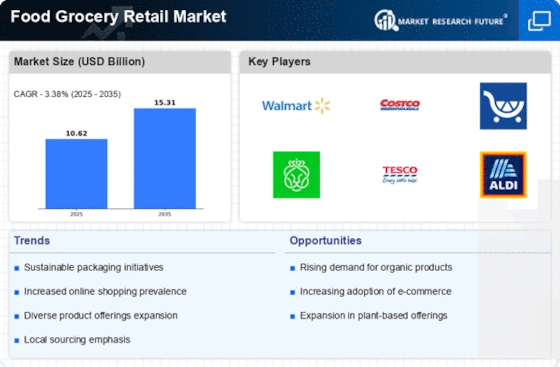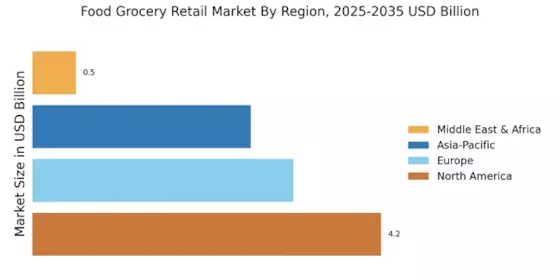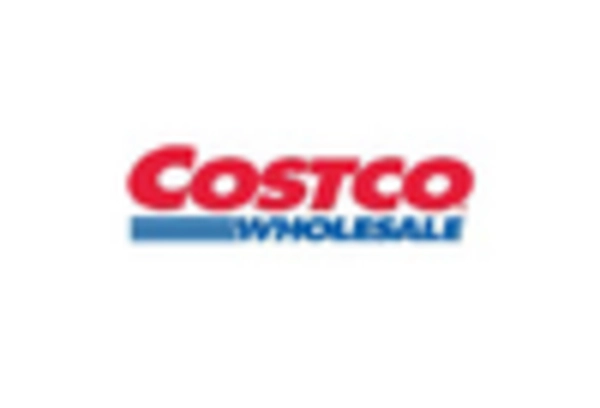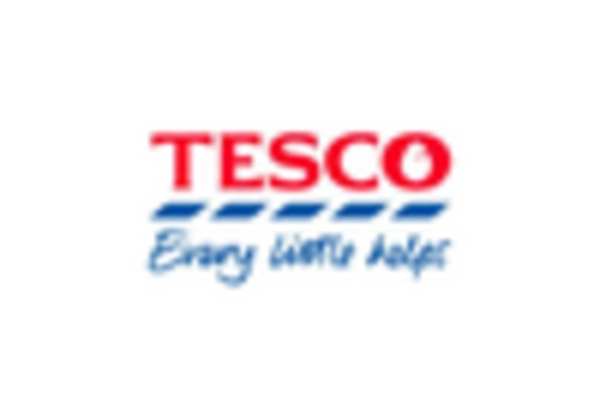The Food Grocery Retail Market is currently characterized by a dynamic competitive landscape, driven by evolving consumer preferences and technological advancements. Major players such as Walmart (US), Costco (US), and Aldi (DE) are strategically positioning themselves to capture market share through various operational focuses. Walmart (US) continues to innovate its supply chain and enhance its e-commerce capabilities, while Costco (US) emphasizes membership-based pricing and bulk purchasing to attract cost-conscious consumers. Aldi (DE), on the other hand, leverages its no-frills approach to maintain low prices, appealing to budget-minded shoppers. Collectively, these strategies contribute to a competitive environment that is increasingly focused on efficiency, customer experience, and value delivery.
Key business tactics within the Food Grocery Retail Market include localizing manufacturing and optimizing supply chains to enhance responsiveness to consumer demands. The market structure appears moderately fragmented, with a mix of large multinational corporations and regional players. The collective influence of key players shapes pricing strategies and product offerings, creating a competitive atmosphere where differentiation is essential for success.
In September 2025, Walmart (US) announced the expansion of its automated fulfillment centers, aiming to enhance its delivery capabilities and reduce operational costs. This strategic move is likely to bolster Walmart's competitive edge by improving efficiency and meeting the growing demand for online grocery shopping. The investment in automation reflects a broader trend within the industry towards leveraging technology to streamline operations and enhance customer service.
In August 2025, Costco (US) unveiled plans to introduce a new line of organic products, responding to the increasing consumer demand for healthier food options. This initiative not only aligns with current health trends but also positions Costco to attract a more health-conscious demographic, potentially increasing its market share in the organic segment. The focus on organic offerings indicates Costco's commitment to adapting its product range to meet changing consumer preferences.
In July 2025, Aldi (DE) launched a sustainability initiative aimed at reducing plastic waste in its packaging. This move is indicative of a growing trend among retailers to prioritize environmental responsibility, which resonates with consumers increasingly concerned about sustainability. By enhancing its sustainability practices, Aldi not only addresses consumer expectations but also strengthens its brand image in a competitive market.
As of October 2025, the Food Grocery Retail Market is witnessing significant trends such as digitalization, sustainability, and the integration of artificial intelligence in operations. Strategic alliances among key players are shaping the competitive landscape, fostering innovation and collaboration. Looking ahead, competitive differentiation is likely to evolve from traditional price-based competition to a focus on innovation, technology, and supply chain reliability, as companies strive to meet the demands of a more discerning consumer base.


















Leave a Comment